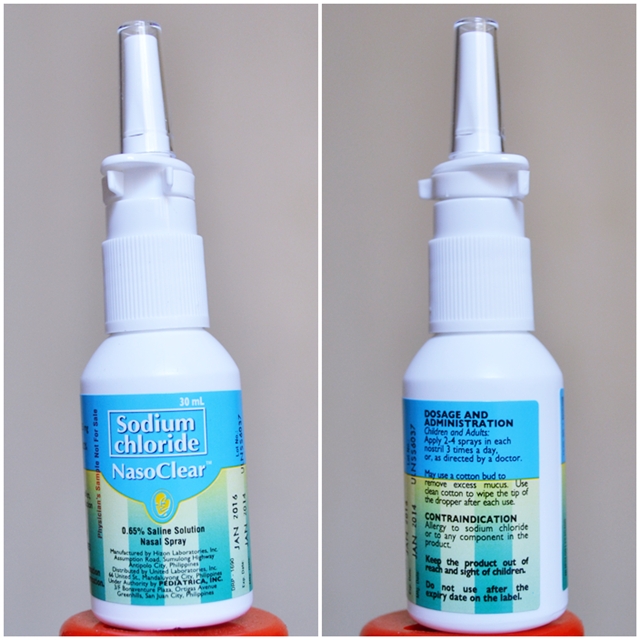For most of my life, I have always suffered from allergic rhinitis—a condition characterized by constant runny nose, nasal congestion, sneezing, and nasal stuffiness. Trust me, having rhinitis is not as innocent as it seems because colds can make life pretty miserable. In this article, let me share with you how NasoClear Saline Nasal Spray Solution has helped to lessen the occurrence of this allergic reaction in two weeks of regular use and also simple instructions on how to use NasoClear.

Discovering and Treating Allergic Rhinitis
Throughout primary school to college, rolls of soft tissue paper, towels and handkerchiefs were my best buddies. Katinko Ointment has as well served many years in reducing earaches, headaches and stuffiness of the nasal passages, helping me save sanity just whenever allergic rhinitis pangs.
Anxiety ridden, my first checkup with our family doctor (EENT) who diagnosed my case of allergic rhinitis was way back in 1999. The doctor examined the inside of my nose with an instrument called a speculum. A painless examination was conducted for him to check for redness and other signs of inflammation. The findings were that I had swollen mucus membranes in the nose and also swollen nasal polyps.
He explained that there are two types of allergic rhinitis: seasonal rhinitis and aperiodic (or perannual) rhinitis. Seasonal rhinitis is triggered by being allergic to pollen, while aperiodic rhinitis is caused by non-seasonal allergens present all year round. These include house dust mites, cockroaches and mold, which flourish in warm, damp conditions, and also animal hair. I had both.
Some studies suggest that air pollution, such as car engine emissions, and cigarette smoke can aggravate allergic rhinitis. I used to take public transportation every day to and from work. With black smokes coming vividly out of the automobiles’ engines and smokers puffing thick cigarette smokes everywhere in the streets, riding in the jeepney is like embracing the fact that all air to be inhaled is polluted and you’re left with no other choice but breathe it in. These contaminants lead to higher bacterial levels, thereby worsening the allergy.
Besides air pollutants, studies also suggest that allergic rhinitis has a strong genetic component. I learned that my uncles and some of my cousins have it, too. It was then confirmed that I am one of the unfortunate members in the family to have been caught by the disease. 🙁
The doctor prescribed me to use nasal spray every day upon waking up and before sleeping at night. I followed his recommendation for about three months until instances when sneezing attacks by allergic rhinitis were diminished to a minimum. However, not long after, the irritating condition came back and it’s even worse after having common colds.
Then I had this self-discovery: sleeping and/or staying in places without air conditioner on stops the nasal problem. I started to prefer sleeping only with electric fan on and sometimes just keeping the windows open at night to let air in so that I won’t have problems the next morning. I’m not sure if this has any scientific basis, but the scheme has been working pretty well, at least on me. I’m now able to breathe better with warmer air.
However, since it’s summertime now, temperature in the Philippines becomes too hot to the point that comfort when sleeping is compromised, when it’s only natural air or the electric fan that circulates air in the room. Because of this, we can’t help but turn the air conditioner on. Hence, my nasal passages become vulnerable again to allergic rhinitis. The quick remedy is sleeping with comforter or huge blanket over my head, so cold air would not pass through my nostrils easily.
NasoClear by Unilab Lessens the Occurrence of Allergic Rhinitis
Recently, I have encountered a quality product by Unilab called NasoClear. It’s packaged with a pump-mist bottle designed to aid in the relief of irritation caused by pollutants, allergens and germs in the nasal passages.

I’ve been using NasoClear for about two weeks now. What I feel is that NasoClear Nasal Spray dissolves mucus and helps clean and moisturize nasal passages. It’s a refreshing, preservative-free, hypertonic saline solution that provides relief from nasal congestion.

NasoClear Nasal Spray makes breathing easier. The medicine contains sodium chloride solution, a salt solution that treats dry or irritated nasal passages. As such, NasoClear 0.65% Saline Solution provides relief for dry, crusted, irritated and inflamed nasal membranes due to colds, allergies, low humidity, heat, environmental factors, air travel, use of steroid nasal spray, overuse of topical nasal decongestants and other nasal solutions, chronic sinusitis or rebound sinus reacting from smog.
How to Use NasoClear
1. Tilt your head forward and breathe out. Hold the nozzle between your fingers and squeeze.
2. Spray the solution into one nostril while covering the other nostril.
3. Spray two times in each nostril in the morning and at night.

People who are allergic to sodium chloride and/or benzalkonium chloride should not take NasoClear. Undesirable effects usually do not occurs. However, if the inside of your nose is very dry and irritated, stinging may occur and this may induce also to transient sneezing. Regarding overdosage, there have been no reports of overdose with this product so it may be used as necessary for about three times a day. If your condition persists or worsens, consulting a doctor is a must. Tell the doctor what you are taking especially medicines for cough, cold or allergy.
It’s best to keep NasoClar out of reach and sight of children. Do not share this product with others because of the possible increased risk of infection. Also, as with any other medicines, do not use it after expiry date on the label.
NasoClear is manufactured by Hizon Laboratories, Inc. and is distributed by United Laboratories, Inc. (Unilab). To know more about NasoClear and other health products and tips, follow Unilab on Facebook and Twitter. For inquiries, you may drop your email at info@unilab.com.ph.

Leave a Reply